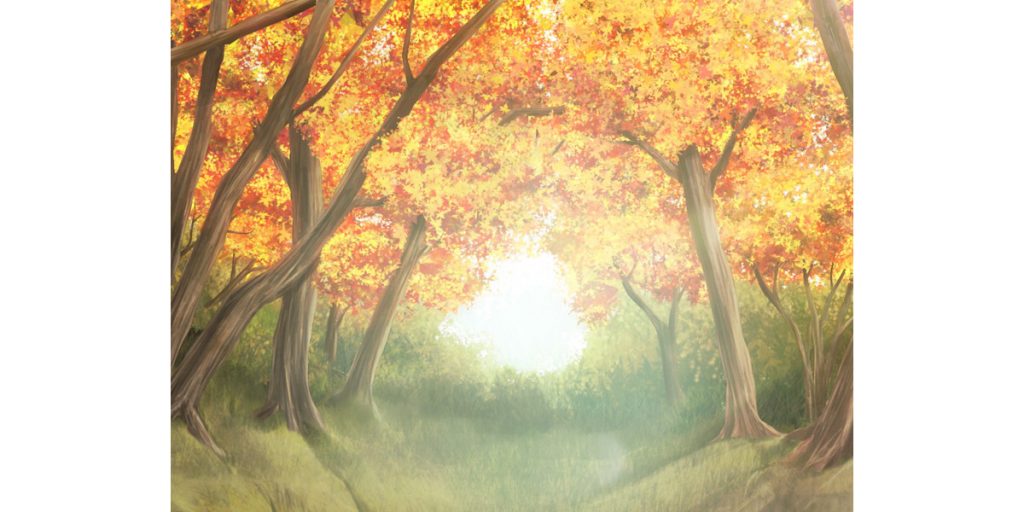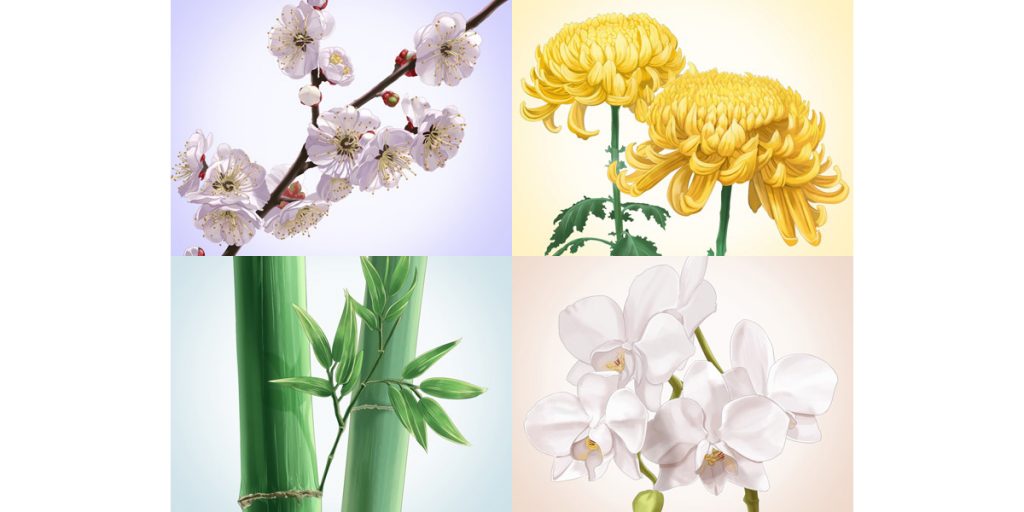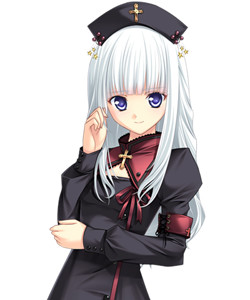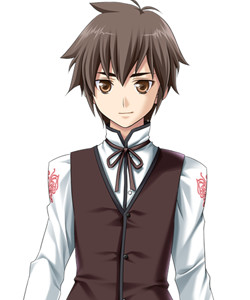
The fall of autumn leaves can be as special as that of cherry blossoms.
This article may have some mild conceptual/structural spoilers in its body. The “On Naming” section has moderate, but comparatively unimportant spoilers.
Kitto, Sumiwataru Asairo Yori mo (Asairo), written by Shumon Yuu, is a multifacted work. On the surface, it tells a very human tale – about relationships & the impact that people have on one another. Beneath the surface, like the reflection of a lake pool, it develops an intricate, at times cryptic folklore-inspired mystery. Yuu imparts this story by weaving wordplay and symbolism into his writing – surprisingly, while the prose feels well thought-out (elegant), it remains very approachable. All of this is bettered by Yuu’s personal touch on the work’s direction – making the most evocative, profound scenes all the more awing.
Asairo is distinctively Japanese. In the opening scene, Yuu pens a vivid description of the scenery – likening the mountain to a canvas onto which vibrant colors descend from the sky to paint a picture called Autumn. A traditional-sounding, majestic soundtrack accompanies Yuu’s poetic prose, immersing the reader into the worldview of the work. Later, the protagonist reunites with his childhood friends at Yumemidori Academy (夢見鳥), an art school nested in the mountains. Each of the protagonist’s childhood friends have names representing one of the shinkunshi (士君子), or “The Four Noble Ones” [more on this in the below section]. Through this setup, Yuu delves into topics distinctive of Japanese culture, including the concept of wabisabi (侘寂), the folklore of Momiji (紅葉), and the spirit of Autumn.
Few works are as intentionally written as Asairo is. The work weaves the intricacies of its writing to accentuate its character dynamics and themes. The central folklore-inspired mystery in this work is comprehensible only by diving deep into the etymology behind the kanji letters (a process which the work actually explicates). The emotionally evocative scenes are bettered by a recurrent, softly-spoken poetic cadence. Wordplay is used to define – and to symbolize the characters and the relations that they have with one another. The themes – and the plot is ultimately told through specific, intentional usage of the intricacies of the Japanese language.

Despite all the technical prowess that Yuu shows in his writing, the work is still fundamentally warm – as a tale of friendship and growth. The main characters (and by the end of the work, the extended cast) are endearing, as their actions exude sensibility & care. The reader gets an inside look at the minds of these characters through frequent perspective shifts, which contributes to the “connectedness” of the cast. To top it off, the comedy in the work is consistently well-written, leaving the reader wanting more by the end. Thus, Asairo’s strong surface level substance combined with Yuu’s polished writing culminates in an intellectually-stimulating, but also, viscerally-satisfying reading experience.
As mentioned throughout this article, Yuu is a very intentional writer. In the section below, I dive deeper into how Yuu uses the Japanese language to craft his work. In particular, I focus on how Yuu uses language – its etymology & literal meanings – to provide significance to his characters’ names. This section will contain some moderate spoilers (but nothing that should ultimately detract from your enjoyment of the work).
The main characters in Asairo are childhood friends who in the past, formed a play group called the shinkunshi (“the four noble ones”), through which the protagonist made some of his happiest childhood memories. The events that the shinkunshi experienced go on to greatly affect them – even after having grown up.

The shinkunshi (四君子) is a collective term referring to four plants: the plum blossom (梅, ume), the orchid (蘭, ran), the bamboo (竹, take), and the chrysanthemum (菊, kiku). These four plants are said to embody a noble, refined beauty, and literari have imbued them respectively with virtues.

The plum blossom (梅, ume) is said to embody inner beauty and humble display under adverse conditions. Kashi Harutsuge (樫 春告) plays the role of the big sister in the group & exemplifies these traits. Her name does not directly match with the plum blossom as ume (梅), but she is connected as such: the plum blossom as ume (梅) has many other appellations, including kobunboku (好文木), konohana (木花), and kazemachigusa (風待草). Of these, there is one appellation by the name of harutsugesa (春告草). Since her name is Kashi Harutsuge, she can be said to embody the plum blossom as harutsugesa.

The orchid (蘭, ran) is said to embody humility and nobility. Yumeno Araragi (夢乃 蘭) is considered the “sun” of the group and predictably has these virtues. She is said to be the orchid (蘭) because her name (夢乃 蘭) encapsulates the kanji for it. Note that although (蘭) is ordinarily pronounced as ‘ran,’ it can also be pronounced as Araragi, as when used in a name.

The chrysanthemum (菊, kiku) is said to embody the virtue to withstand all adversities. Kumigami Hiyo (与神 ひよ) is the sole heroine of the work and embodies this virtue. Like Araragi, she belongs to this group because of her name. The work reveals later on that her name ひよ is represented by the kanji (菊世). Since her name (菊世, Hiyo) contains (菊), she is said to embody the chrysanthemum.

The bamboo (竹, take) is said to embody tolerance, durability, and open-mindness. The protagonist is actually named Suu Sasamaru (崇 笹丸). On the surface, Sasamaru shouldn’t be in the group because his name Sasamaru (笹丸) contains the character for sasa (笹), or bamboo grass. Bamboo grass (sasa, 笹) is distinct from bamboo (竹, take). Hiyo initially invites the protagonist into the shinkunshi through the justification that sasa (bamboo grass) is basically take (bamboo). This nuance serves as a major plot point in Asairo, as the protagonist views this as an act of kindness which he didn’t deserve (indeed, the protagonist strongly believes that sasa is sasa and cannot become take).
By crafting the group dynamic as such, Yuu is actually able to give greater effect to the character developments that follow. Of importance is Hiyo’s stance that although Sasamaru isn’t take (竹), through his actions, he’s able to be more take (竹) than take (竹) is. The actual meaning behind that line is well-developed, and encapsulates one of the work’s major themes – namely that of growth (through imperfection).
けれど、やはり“笹”は“笹”だ。 “竹”にはなれない。
Suu Sasamaru on ‘笹”
だってあなたは、竹よりもなお竹らしい笹ですもの… ええ。だんなさまは誰よりも真っ直ぐで、折れる事を知らず、ただ真摯に空だけを見つめておられた
Kumigami Hiyo on Sasamaru
[Take my word that the above sounds far more poetic in Japanese than English. Purpose of the section was to provide a brief synopsis of the characters, and to show just how interwoven the use of language is in Asairo.]
I probably won’t be able to read Asairo in a few years (Need to get better at 日本語) but this review made my interest for the game rise up considerably. Especially loved the trivia part about the names. Keep up the good work!